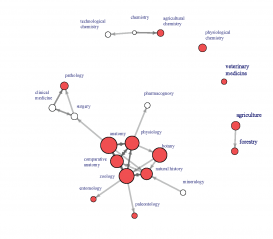The closing decades of the eighteenth century witnessed the start of a “second scientific revolution” in which the generalized scientific society gave way to specialized institutions for scientific disciplines. The founding of new institutes in the life science exemplifies this process, as utilitarian distinctions between the study of natural history, medicine, and agriculture gave way to a profusion of new disciplines, including biology, physiology, pathology, comparative anatomy, and many others. Within German universities many new disciplines became first established as specialized research institutes with their own budgets, support staff, and research equipment.
This project combines traditional historical research with computational and quantitative techniques drawn from social network analysis to compare the activities of a variety of different discipline-building programs in Germany. The proliferation of life science disciplines makes it possible to consider why some scientific disciplines became widely institutionalized while others were marginalized. At the MPIWG, this project will focus on the role of coalitions of scientific, state, and market actors in determining the success of individual disciplines. In particular it will examine how each of these different groups made inferences about the potential value of new disciplines both within the university and elsewhere.

